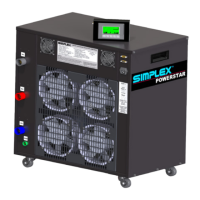Page
25
9.0 DIAGNOSTICS AND TROUBLESHOOTING
9.1 Introducon
Through good pracce, cumulave issues can be prevented through basic maintenance.
In the unlikely event that something goes wrong with the load bank, we will cover how
to solve some of the more common problems. Finally, if the need arises, we will cover
how to replace various parts for the load bank.
In this secon, you will learn:
— How to perform preventave maintenance on the placeholder hardware.
— Some common issues that you may run into and how to troubleshoot these
items independently.
— The part names and numbers, and each of the primary funcons is in the load
bank.
9.2 General Maintenance
The load bank has been designed to require minimum maintenance. All components
have been chosen for a long, reliable life. Two basic intervals of maintenance are
required: each operaon and either
every 50 hours or 6 months (whichever
comes rst).
9.2.1 Each Operaon
The air intake screens and
louvers, fan and cooling chamber,
and exhaust openings must be
checked for any obstrucons or
foreign objects. Due to the high
volume of air circulated, paper
and other items can be drawn
into the air intake. During load bank operaon, ensure that air is exing from the
exhaust vent. The load branches should be checked for blown fuses or opened
load resistors. To check the fuses or load resistors, operate the load bank from
a balanced 3-phase source and check the three-line currents. The three-current
readings should be essenally the same. If a sizable dierence is noted, one or
more load fuses or load resistors may have malfunconed.
9.2.2 Every 50 Hours or 6 Months
Check the ghtness of the electrical connecons. The expansion and contracon
caused by load bank operaon may result in loose connecons. The vibraons
caused by the cooling fan may also loosen electrical connecons. If the load bank
is transported long distances, the electrical connecons should be checked for
ghtness at a shorter-than-normal me interval. For a detailed inspecon guide,
see “4.3 Primary Inspecon” on page 13.
WARNING
Always remove all power from the
load bus and all fan/control power
before servicing the Load Bank.
Never operate or service a Load
Bank that is not properly connect-
ed to an earth-ground.

